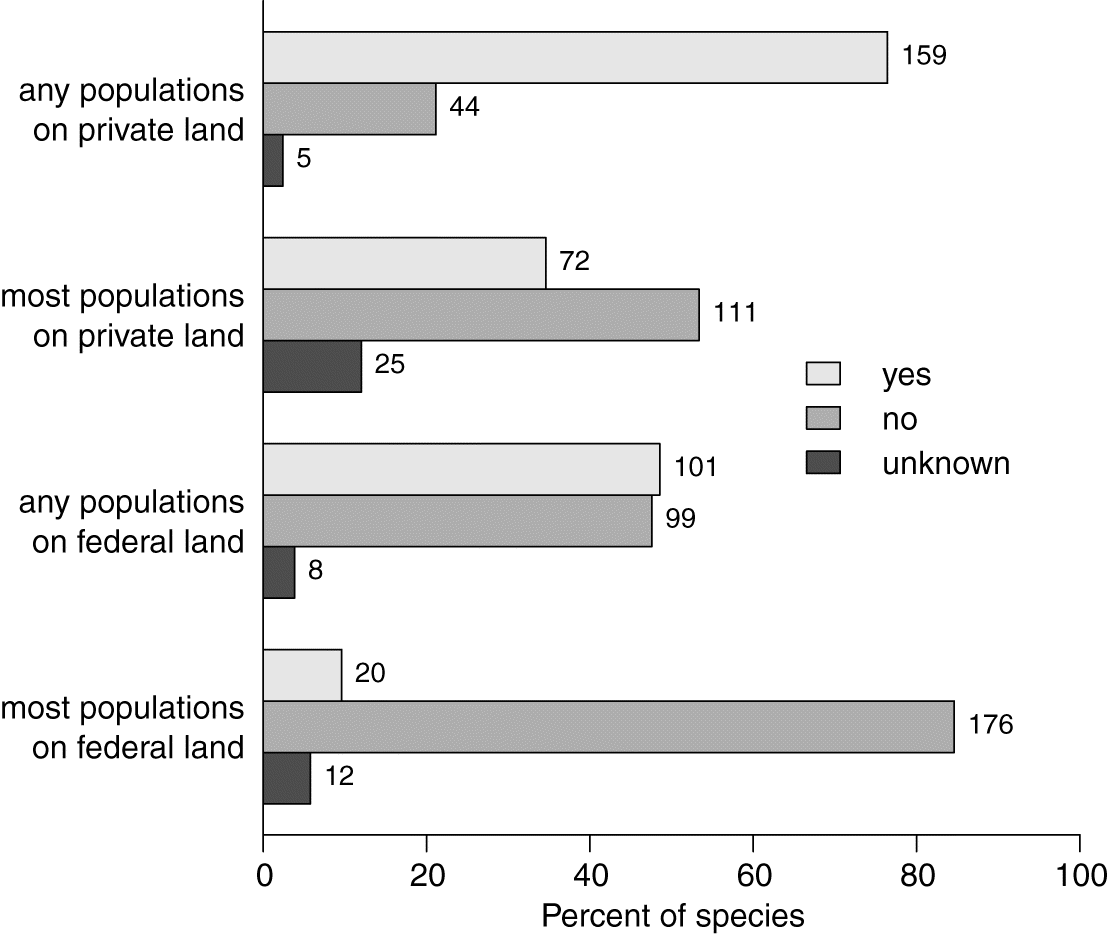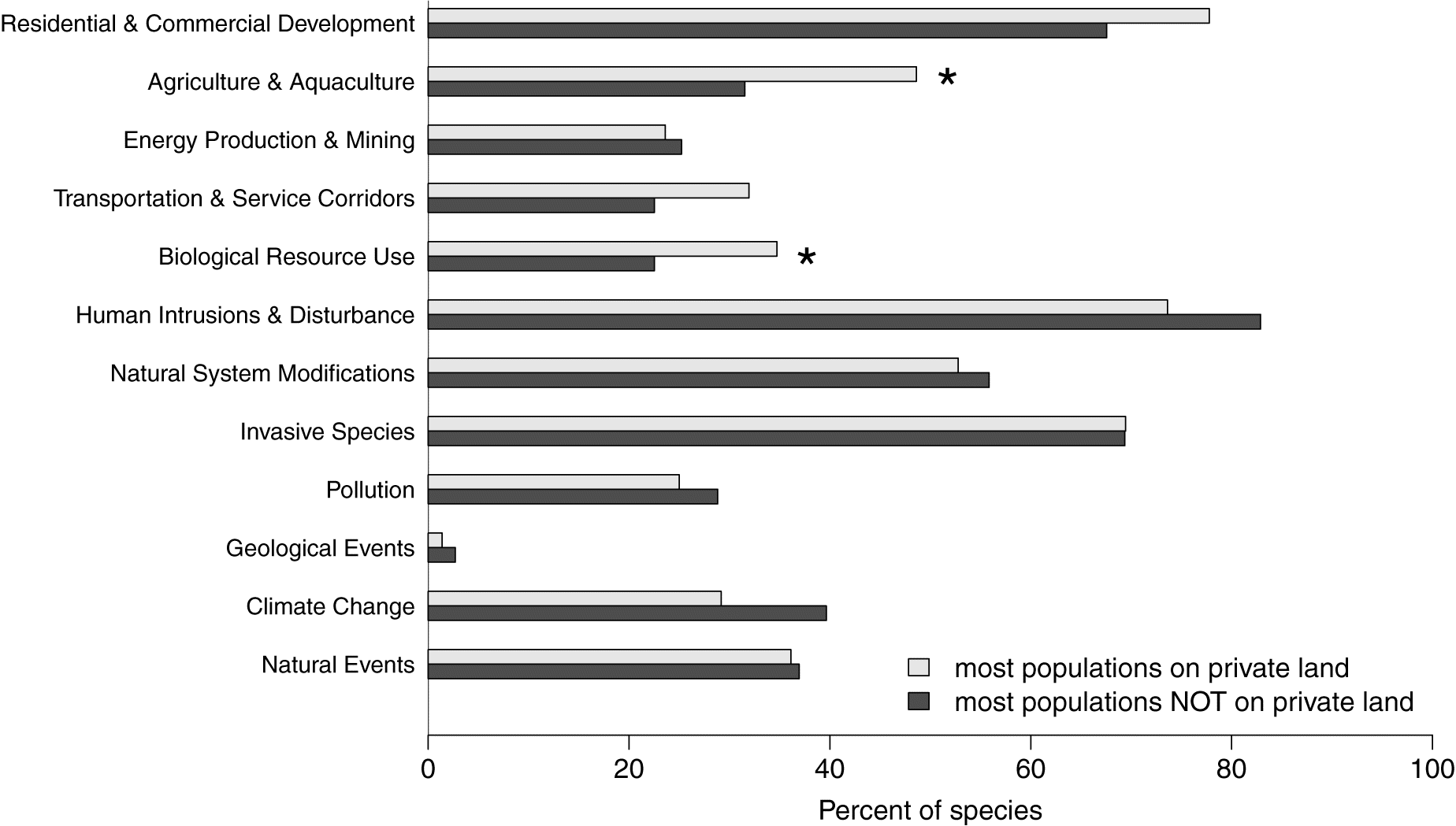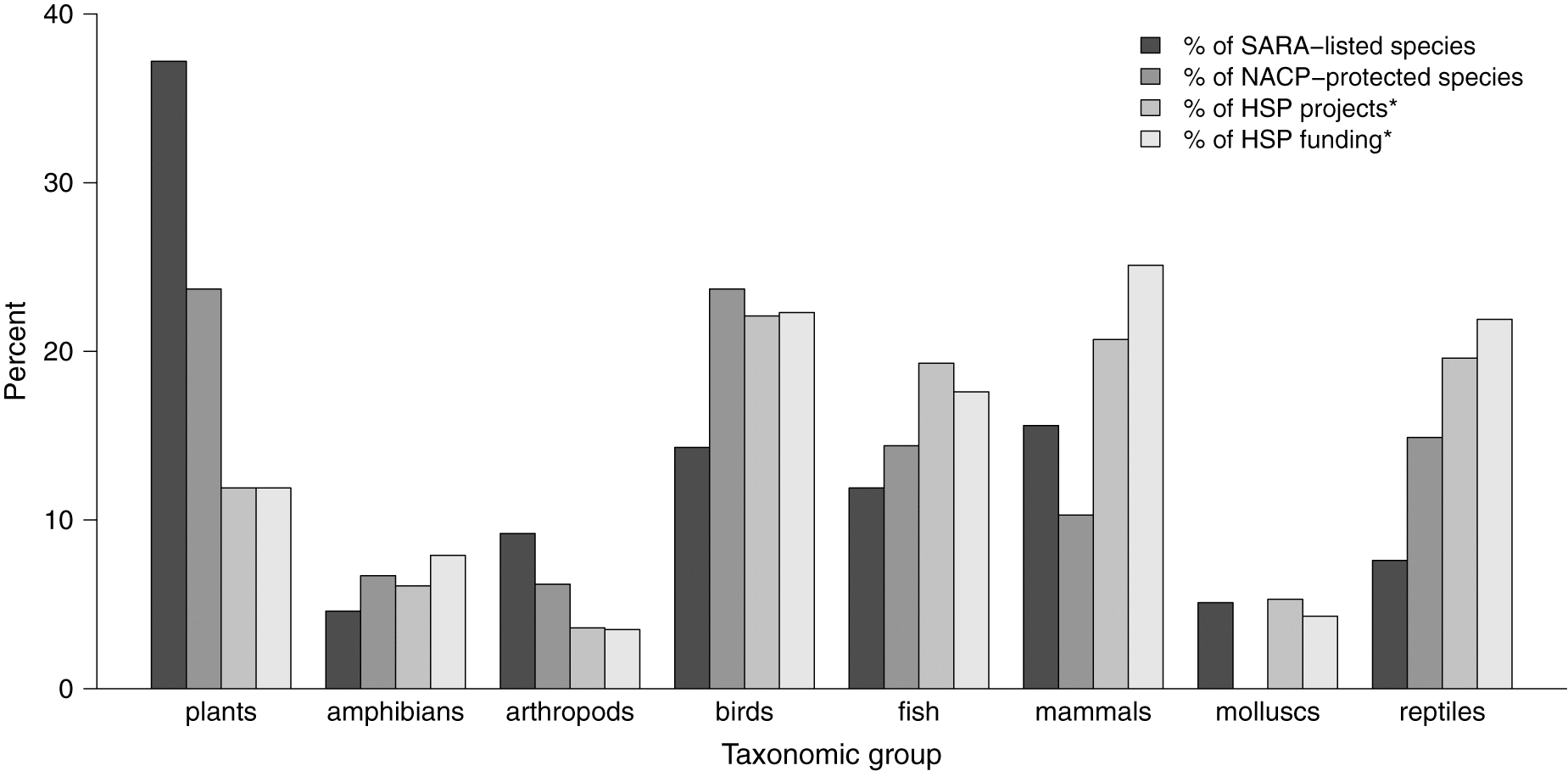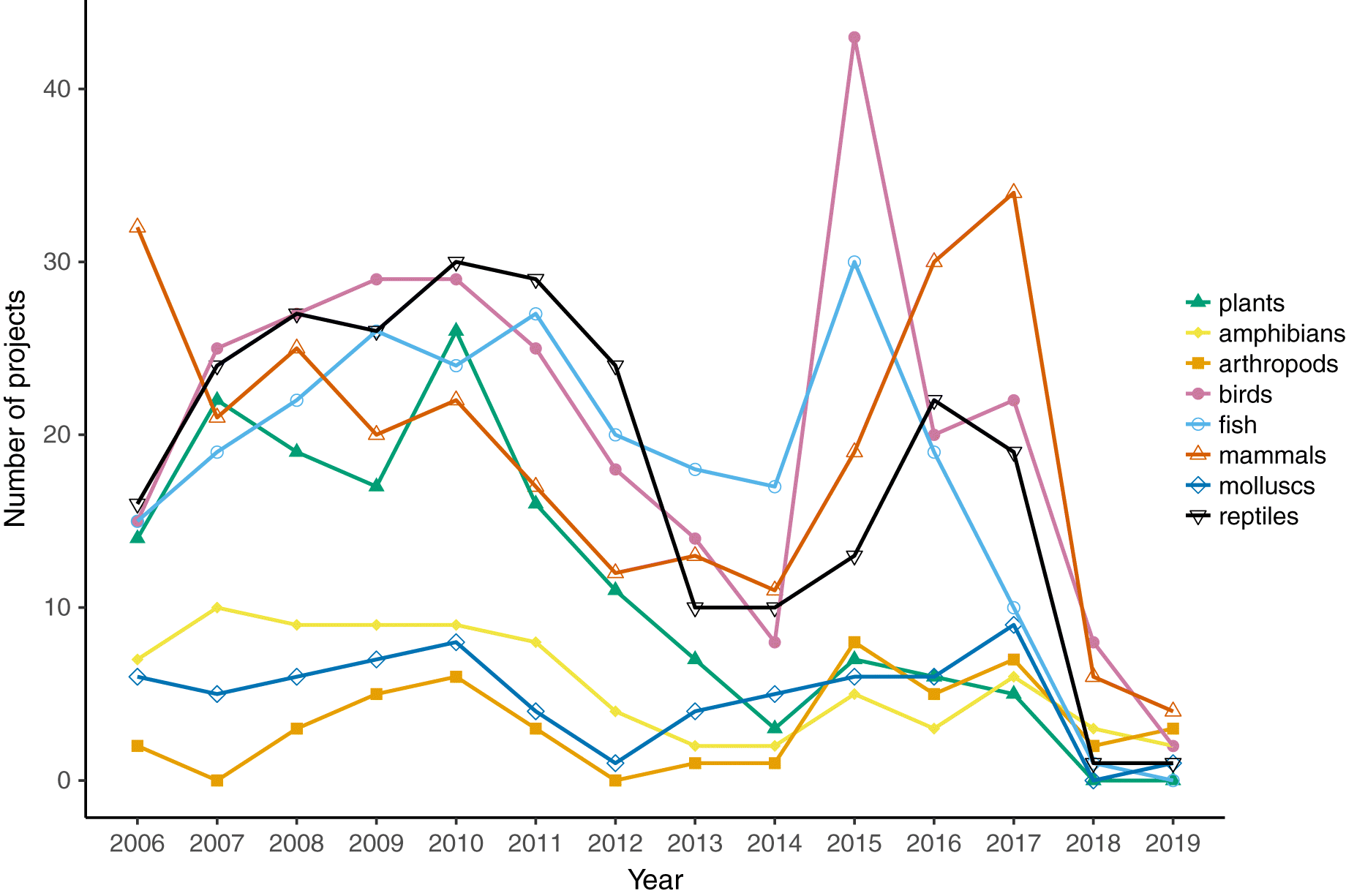Introduction
Canada’s
Species at Risk Act (SARA) was designed to prevent extirpations and extinctions and aid the recovery of species in Canada (
SARA 2002). As of December 2018, plants and lichens together form the single largest group of species listed under the legislation as extirpated, endangered, threatened, or special concern (37% of the total;
Government of Canada 2018). Unlike the
United States Endangered Species Act (US ESA), SARA does not automatically protect listed species and their habitat, except in areas of federal jurisdiction (
SARA 2002). However, in the United States, the prohibition against destruction of listed species or their habitat does not apply to plants (
Evans et al. 2016). Therefore, the automatic protection afforded to plants in Canada—as in the United States—depends on the extent to which they occur on federal lands.
We expect that most populations of listed plant species in Canada are not on federal land, where they have legal protection. In Canada, biodiversity is highest in the far south, which is also where the human population density is highest (
Coristine and Kerr 2011). While there are some exceptions—for example, the endemic flora of the Athabasca sand dunes in northern Saskatchewan (
Environment Canada 2013)—most listed plant species in Canada are associated with vegetation types that reach the northern limit of their North American range in southern Canada. These include the Garry Oak savannahs of southwestern British Columbia; the grasslands of the North American Great Plains extending into southern British Columbia, Alberta, Saskatchewan, and Manitoba; the Carolinian forests of southern Ontario; and the Atlantic Coastal Plain in Nova Scotia (
Argus and Pryer 1990;
Parks Canada Agency 2006;
Environment and Climate Change Canada 2018a). Most of the land in these regions is not federal land. For example, most forests in southern Ontario are privately owned (
Ontario Ministry of Natural Resources 2016). But the actual proportion of plant populations on private land has not been quantified. This is clearly an information gap, and it also presents a precarious situation in which the combination of incomplete knowledge of the locations of plant species at risk and a lack of federal protection on most lands could lead to the loss of populations before they are even known.
In addition to determining legal protection, land tenure could affect the threats faced by plant species at risk and trends in their populations. For example,
Hatch et al. (2002) found that plants found primarily on federal land in the United States were less likely to be threatened by construction of residential areas, roads, or utilities than plants on other lands. In the United States, listed plant species found primarily on federal land were also more likely to be improving in status, although this pattern could be a result of better monitoring or easier implementation of recovery actions on federal land (
Rachlinski 1998;
Hatch et al. 2002). In Canada, human intrusions and disturbance, mainly via recreational activities, pose the most frequent threat to plant species at risk (
McCune et al. 2013). Given the sometimes heavy recreational use of federal lands, including National Parks, this threat might actually be greater for species found primarily on federal land. There has been no analysis of trends in plant species status over time in relation to land tenure in Canada.
Canada’s management of species at risk emphasizes stewardship first, rather than regulation of activities on private lands (
Olive 2014). To support this goal, the Canadian government created programs for the protection and stewardship of species at risk. In this paper, we examine two of the biggest programs, which take different approaches to contributing to the conservation of species at risk and for which we could make the links back to the individual species targeted. The first is the Natural Areas Conservation Program (NACP;
Nature Conservancy of Canada 2016), which matches federal funding with contributions from private donors or environmental nongovernment organizations to purchase or otherwise secure private land for conservation. This program has been funded through three separate agreements, totaling $345 million from 2007 to March 2019 (
Environment and Climate Change Canada 2018b). The goals are to secure land for long-term conservation, implement stewardship activities on secured lands, and build capacity within the land trust community. The second is the Habitat Stewardship Program (HSP), which began in 2006, and allocates approximately $12.2 million per year to projects that conserve species at risk and that prevent other species from becoming a conservation concern (
Environment and Climate Change Canada 2018b). HSP projects can be carried out on private land or provincial Crown land, and applications are open to nongovernmental organizations, citizen groups, as well as provincial, territorial, and municipal governments. For example, the Native Plant Society of Saskatchewan has received funding from the HSP for their “Rare Plants and Ranchers” project. Over 2100 projects have been funded by the HSP so far, with a focus on supporting implementation of SARA (
Environment and Climate Change Canada 2018b). In the United States, plants at risk receive far less funding for recovery actions compared with other taxa (
Negrón-Ortiz 2014). In Canada, no one has quantified how much attention or resources are allocated to plants through the NACP or the HSP relative to other taxonomic groups.
In this study we focus on plant species at risk in Canada. We analyze official status reports and related documents and publicly available data on federally funded programs to determine: (i) how many plant species at risk occur mainly on private land, (ii) whether species found mainly on private land differ in terms of the main threats they face or changes in their status over time compared with other plants at risk, and (iii) if conservation actions for SARA-listed plant species are funded under the NACP and the HSP in proportion to their numbers.
Materials and methods
We used the online Species at Risk Public Registry to compile a list of 234 vascular plant, moss, and lichen species listed as Extirpated, Endangered, Threatened, or Special Concern by the Committee on the Status of Endangered Wildlife in Canada (COSEWIC;
Government of Canada 2018). Note that we use the term “species” to indicate species, populations of species, or sub-species assessed by COSEWIC. We also include lichens in our tally, although they are not technically plants, because of their similar characteristics (e.g., photosynthetic, sessile). COSEWIC is an independent panel of experts that has been assessing the status of species in Canada since 1977 (
The Committee on the Status of Endangered Wildlife in Canada 2019) and provides guidance regarding which species should be listed under SARA. However, not all species recommended for listing by COSEWIC receive legal status under SARA.
Land tenure of Canada’s plant species at risk
To determine whether each species is found on federal and (or) private lands, we examined documents that are freely available in the registry, including Status Appraisal Summaries and Status Reports (prepared by COSEWIC in the process of assessing species’ status), and Recovery Strategies and Management Plans (prepared for species listed under SARA). Most Status Reports include a section called “Habitat Protection and Ownership”, which summarizes the land tenure of the known populations of each species. Information on land tenure is also sometimes available in Recovery Strategies and Management Plans. Where more than one document included information on land tenure, we used the most recently published document.
Following the definition given in the SARA legislation (
SARA 2002), we included the following land types in our definition of federal land: federal Crown land, National Parks and Historic Sites, National Defence bases, First Nations reserve lands, and Crown land in the three northern territories. Most Crown land in the provinces is under provincial jurisdiction. We define private land as land owned by individuals or corporations. This does not include lands held by municipalities or regional agencies or in provincial parks and reserves. Note that land tenure does not strictly correlate with the level of protection. Some privately owned land may be protected from development, for example by conservation easements, or when the owner is a private nature trust or an environmental nonprofit organization.
To assess the distribution of species among different land tenures, we focus on the number of populations rather than the number of individuals of each species, because populations are the basic unit of protection for plant species at risk; ensuring survival requires protection and recovery of as many viable populations as possible (
Hanski et al. 1996;
Heywood and Iriondo 2003). For each species, we asked four distinct questions: (
i) Are any known populations on private lands? (
ii) Are the majority (>50%) of known populations on private lands? (
iii) Are any known populations on federal lands? (
iv) are the majority (>50%) of known populations on federal lands? If exactly 50% of the known populations of a species were on federal land, or exactly 50% of the known populations of a species were on private land, we based the answer to questions (
ii) and (
iv) on whether the greatest number of individuals occurred on that tenure type. We answered yes, no, or unknown for each of these questions (see
Table S1). Note that because of the mix of possible land tenures, the majority of the known populations of a species could be on neither private nor federal land.
To assess the threats faced by each species listed under SARA, we used recovery strategies and management plans. We applied the International Union for Conservation of Nature threat classification system (
Salafsky et al. 2008) to the threats described in each recovery strategy, and noted which of the 12 threat categories were present.
McCune et al. (2013) compiled some of these data; we supplemented these data with data for species with recovery strategies or management plans published after 2013.
To assess the effect of land tenure on changes in species status, we used the data from
Favaro et al. (2014). They recorded changes in status for all species that had been assessed more than once by COSEWIC up to December 2013. They determined whether each species had declined in status over time (e.g., were at greater risk, for example starting at Special Concern and then re-assessed as Threatened or Endangered). We combined species that were assessed as less endangered from earlier to later assessments, or maintained the same status. We used Fisher’s exact tests to determine whether species observed primarily on private land or not had significant differences in (
i) the primary threat types present and (
ii) their status changes over time (declining vs. not declining).
Representation of plant species at risk in federal programs
To examine how well the NACP secured lands that support plant species at risk, we used the numbers presented in the eighth annual progress report on the program (
Nature Conservancy of Canada 2015). The report summarizes sightings of species at risk during surveys on properties secured under the NACP, by taxonomic group, from 2007 to 2015. These surveys are done before acquisition of properties and then through ongoing monitoring. We compared the proportion of species in each taxonomic group reported on these properties to the proportion with status under SARA. We also tested whether plant species that occur mainly on private land are better represented on NACP-secured lands. These species could potentially benefit most from the purchase and protection of private land under the NACP.
To evaluate the HSP, we obtained a list of all 2121 funded projects and the total amount of funding awarded for each project since the program began in 2006 from Environment and Climate Change Canada. To determine which taxonomic groups were targeted, we used the project titles and names of the organizations that undertook each project. For some projects, we could not determine which taxonomic group was targeted. For example, a project entitled “Building Conservation Connections for the Recovery of Species at Risk on British Columbia’s South Coast” carried out by the Fraser Valley Conservancy could have included species at risk from several taxonomic groups. However, for many projects it was possible to determine taxonomic groups, and sometimes the species, targeted. For example, “Assessing Fish Habitat Along Tributaries of the South Saskatchewan River” clearly targeted fish, and “Assisting Piping Plover recovery in the Great Lakes through species inventory, monitoring and habitat protection” supported action for a particular bird: the piping plover. Thus, we estimated what proportion of projects with determinable targets were focused on vascular plants, mosses, or lichens. We used the data on the amount of money awarded for each project to calculate the total funding allocated to each taxonomic group.
Discussion
Our findings show that there is a strong need for Canada to promote stewardship of plant species at risk on private lands. Most plant species at risk listed under the SARA are not found primarily on federal land and as a result do not benefit from the automatic protection granted under SARA. In addition, more than three-quarters of plant species at risk have been found on privately owned land. Further, we would expect the recorded number of populations on private land to increase with more surveys on private land. For example, surveys of private forests in southern Ontario regularly turned up previously undocumented populations of plant species tracked by the province or listed under the SARA (
McCune 2016;
McCune et al. 2017b;
Rosner-Katz et al. in press). We do not know what proportion of monitoring and other conservation research in Canada occurs on privately owned land, but we suspect it is low compared with publicly accessible land (cf.
Hilty and Merenlender 2003). Species distribution modeling can be used to make field surveys for plant species at risk more efficient (
Guisan et al. 2006;
McCune 2016;
Rosner-Katz et al. in press), but this does not eliminate the need to increase field surveys targeting plant species at risk, particularly on privately owned land.
We did not identify substantial differences in the threats faced by plant species at risk depending on their occurrence on private lands. This echoes the findings of
Hatch et al. (2002) for endangered species in the United States and highlights the fact that Canadian plant species at risk face many threats, regardless of land tenure. On federal lands in Canada, species at risk (and their critical habitat) are legally protected from outright destruction. Yet, even on federal land, species at risk still face pervasive threats such as human intrusions and disturbance, invasive species, climate change, pollution, and other threats. It is crucial to mitigate the threats to plant populations on private lands as well, given that small, privately owned properties provide important habitat for populations of at-risk plants (e.g.,
McCune et al. 2017b).
The levels of risk for most Canadian plant species have not improved according to COSEWIC status assessments, and the likelihood of improvement does not vary with primary land tenure. However, the results of the re-assessments serve to emphasize the uncertainty regarding the true status of many plant species. Nine out of the 15 species that improved in status did so only because increased survey effort following their listing led to the discovery of previously unknown populations. Again, this illustrates the need to find ways to encourage surveys and monitoring, particularly on private lands that are less travelled by botanists.
Recognizing the need for greater protection on private lands, and to support the “stewardship first” intent of the SARA, the Canadian government has invested hundreds of millions of dollars in the NACP and the HSP. These programs have contributed to the purchase and protection of nearly 400 000 ha of habitat for species at risk (
Nature Conservancy of Canada 2015), and thousands of projects for research, restoration, or education to benefit species at risk (
Table S2). However, plants are not represented in these programs in proportion to the number that are listed. Our findings are similar to findings from other countries in which plants receive less attention than some other taxa (e.g.,
Martín-López et al. 2009;
Oldfield 2010;
Havens et al. 2014;
Negrón-Ortiz 2014;
Evans et al. 2016;
Broadhurst and Coates 2017). SARA does not include provisions for putting a higher priority on some taxonomic groups, other than to rank species according to risk of imminent extinction. However, assessments of the process by which species: (
i) are listed under SARA, (
ii) receive a Recovery Strategy, and (
iii) have critical habitat designated revealed biases related to taxonomy and other factors (e.g.,
Mooers et al. 2007,
2010;
Findlay et al. 2009;
McCune et al. 2013;
Bird and Hodges 2017;
Creighton and Bennett 2019).
We identified three possible explanations for the relative lack of emphasis on plants in the programs we examined. First, if managers implicitly placed a higher priority on species listed as endangered over those listed as threatened or special concern, and if fewer plants were listed as endangered, then these conditions could explain the weaker representation of plants on NACP properties and among HSP projects. However, a higher proportion of plants are listed as endangered than other taxonomic groups, except for arthropods and molluscs (
Government of Canada 2018).
A second possible reason for a lower priority on plants is that many SARA-listed plant species are not endemic to Canada. As noted above, many are associated with vegetation types that extend south into the United States, and some are secure south of the border. However, the observation that Canadian plant species at risk are often at the northern edge of the species range is also true for other taxonomic groups, and the SARA contains no provision for global status to affect efforts to conserve species in Canada.
A third possible explanation is cultural “plant blindness”, resulting in fewer organizations and researchers working on plant conservation, in turn resulting in fewer plant-related applications to the programs (e.g.,
Balding and Williams 2016). Although the administrators of the HSP can only fund projects if they receive an application, they do set funding priorities and could target historically under-represented taxonomic groups, including plants, which could then encourage more applications focused on plants. To support future analyses of program results, we also recommend that the HSP consistently assess and report which species are targeted by the projects it funds. Future work could also examine how the NACP identifies and acquires possible lands for purchase and protection.
The high proportion of plant species at risk on private land and the stewardship-first approach of the SARA necessitate a strong focus on protection of private lands through purchase or voluntary agreements and on programs that engage with landowners to foster awareness and stewardship of these species. Canadians consistently show commitment to the conservation of species at risk, but they resist regulation, desiring incentives and advice instead (
Gray et al. 1993;
Sutherland 1997;
Henderson et al. 2014;
Goodale et al. 2015;
McCune et al. 2017a;
Olive and McCune 2017). The HSP has contributed to some very successful, multi-year programs to promote stewardship of plants on private lands. Two stand out for their documented successes: “Plants on the Edge: The Atlantic Coastal Plain Flora Securement and Stewardship Project” run by the Nova Scotia Nature Trust (
Nova Scotia Nature Trust 2009) and “Rare Plant Rescue”, part of the Stewards of Saskatchewan program run by Nature Saskatchewan (
Vinge-Mazer and Ranalli 2012). Landowner-focused programs like these require reliable, sustained funding. Establishing relationships with landowners is a long-term endeavour, which requires continuity to build trusting relationships between landowners and the organization running the program (e.g.,
Janssen and Williamson 1996;
Sutherland 1997).
At least one of the hotspots for Canadian plant species at risk, southern Ontario, lacks a coordinated landowner stewardship program. Conservation managers began landowner contact and stewardship programs in this region and had measurable success in the mid-1980s and early 1990s (
Hilts and Moull 1985;
Duynstee 1997), but lack of provincial funding led to the demise of these programs, and others like them (S. Hilts 2013, personal communication;
Phair 2014). While committed local environmental groups and volunteers have managed to keep some programs going (e.g.,
Phair 2014), most regions in southern Ontario lack any such programs. These gaps could be filled by the federal government placing a higher priority on projects fostering stewardship of SARA-listed plants on private lands.
Finally, if plant species at risk in Canada are to recover, the Canadian government must actively solicit and fund projects that include conservation, research, and monitoring of plant species at risk, especially on private lands. With better data on where plant populations actually are and their viability, land purchases made under the NACP or programs like it can better select properties that support plant species at risk.





